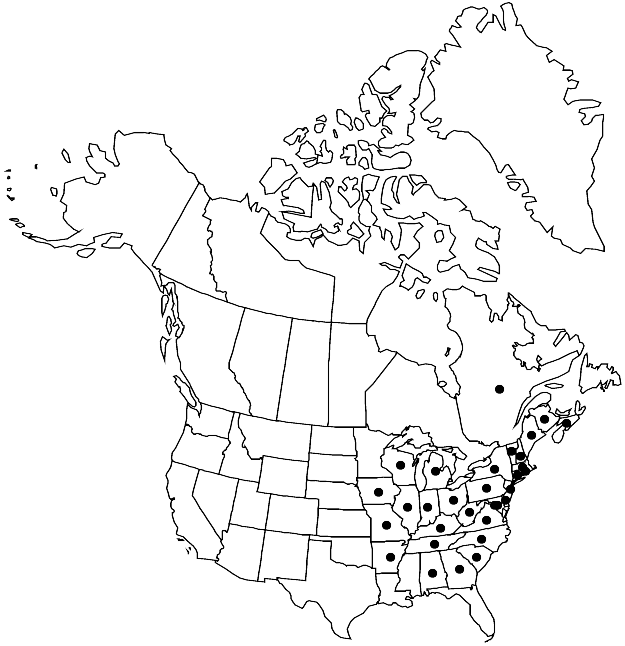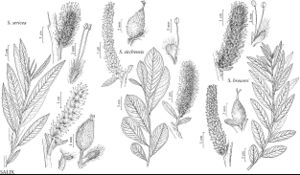Difference between revisions of "Salix sericea"
Arbust Amer., 140. 1785.
FNA>Volume Importer |
FNA>Volume Importer |
||
| Line 12: | Line 12: | ||
|name=Salix coactilis | |name=Salix coactilis | ||
|authority=Fernald | |authority=Fernald | ||
| + | |rank=species | ||
}} | }} | ||
|hierarchy=Salicaceae;Salix;Salix subg. Vetrix;Salix sect. Griseae;Salix sericea | |hierarchy=Salicaceae;Salix;Salix subg. Vetrix;Salix sect. Griseae;Salix sericea | ||
| Line 39: | Line 40: | ||
-->{{#Taxon: | -->{{#Taxon: | ||
name=Salix sericea | name=Salix sericea | ||
| − | |||
|authority=Marshall | |authority=Marshall | ||
|rank=species | |rank=species | ||
| Line 54: | Line 54: | ||
|publication year=1785 | |publication year=1785 | ||
|special status= | |special status= | ||
| − | |source xml=https://jpend@bitbucket.org/aafc-mbb/fna-data-curation.git/src/ | + | |source xml=https://jpend@bitbucket.org/aafc-mbb/fna-data-curation.git/src/f50eec43f223ca0e34566be0b046453a0960e173/coarse_grained_fna_xml/V7/V7_183.xml |
|genus=Salix | |genus=Salix | ||
|subgenus=Salix subg. Vetrix | |subgenus=Salix subg. Vetrix | ||
Revision as of 22:14, 16 December 2019
Plants sometimes forming clones by stem fragmentation. Stems: branches (highly brittle at base), gray-brown or violet, not glaucous, tomentose to glabrescent; branchlets red-brown, violet, or mottled yellow-brown, sparsely to densely velvety. Leaves: stipules absent or rudimentary on early ones, late ones 1.2–4 mm, apex acute or acuminate; petiole convex to flat, or shallowly grooved adaxially, 3.5–12(–21) mm, (sometimes 2 spherical glands distally), velvety adaxially; largest medial blade lorate, narrowly oblong, or narrowly elliptic, (48–)54–82–100(–125) × (7–)9–16.7–25 mm, base cuneate or convex, margins flat, serrulate or crenulate, apex acute, acuminate, or convex, abaxial surface glaucous (sometimes obscured by hairs), densely short-silky, hairs straight, adaxial dull, sparsely pubescent to glabrescent; proximal blade margins entire; juvenile blade reddish or yellowish green, very densely short-silky abaxially, hairs white, sometimes also ferruginous. Catkins flowering as or just before leaves emerge; staminate stout, 13.5–40 × 4–9 mm, flowering branchlet 0–2 mm; pistillate loosely to moderately densely flowered, slender to stout, 18–43 × 5–12 mm, flowering branchlet 1–3 mm; floral bract dark brown, black, or bicolor, 0.8–1.5 mm, apex rounded, abaxially hairy, hairs straight or wavy. Staminate flowers: adaxial nectary ovate to oblong, 0.3–0.8 mm; filaments distinct or connate less than 1/2 their lengths; anthers purple turning yellow, 0.4–0.6 mm. Pistillate flowers: adaxial nectary oblong, ovate, or flask-shaped, 0.4–0.7 mm; ovary ovoid, beak abruptly tapering to styles; ovules 6 per ovary; styles 0.2–0.4 mm. Capsules 2.5–4 mm.
Phenology: Flowering early Mar-early Jun.
Habitat: Wet, boggy shores, sandy terraces, ledges along streams, low woods, sedge meadows, acid bogs, open seepages, rocky, silty, sandy, or peaty substrates, possibly also on serpentine soils
Elevation: 5-1300 m
Distribution

N.B., N.S., Que., Ala., Ark., Conn., Del., D.C., Ga., Ill., Ind., Iowa, Ky., Maine, Md., Mass., Mich., Mo., N.H., N.J., N.Y., N.C., Ohio, Pa., R.I., S.C., Tenn., Vt., Va., W.Va., Wis.
Discussion
Some specimens of Salix sericea are difficult to separate from S. petiolaris (G. W. Argus 1986). Salix sericea can be distinguished from S. petiolaris in having branches highly brittle at base, stipules on early leaves rudimentary or absent, on late leaves usually foliaceous, juvenile blades usually with white hairs, rarely some ferruginous, ovaries ovoid, beaks abruptly tapering to styles, and capsules 2.5–4 mm; S. petiolaris has branches flexible at base, stipules on all leaves absent or rudimentary, juvenile blades usually with conspicuous ferruginous hairs, ovaries pyriform, beaks gradually tapering to styles, and capsules 5–9 mm.
See 68. Salix eriocephala for comments on differences.
Hybrids:
Salix sericea forms natural hybrids with S. eriocephala and S. petiolaris. Reports of hybrids with S. humilis (C. K. Schneider 1921; M. L. Fernald 1950) are not based on convincing specimens.
Selected References
None.
